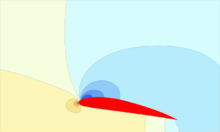Ground effect (aerodynamics)
In fixed-wing aircraft, ground effect is the increased lift (force) and decreased aerodynamic drag that an aircraft's wings generate when they are close to a fixed surface.[1] When landing, ground effect can give the pilot the feeling that the aircraft is "floating". When taking off, ground effect may temporarily reduce the stall speed. The pilot can then fly just above the runway while the aircraft accelerates in ground effect until a safe climb speed is reached.[2]
Principle of ground effect


When an aircraft flies at a ground level approximately at or below the length of the aircraft's wingspan or helicopter's rotor diameter, there occurs, depending on airfoil and aircraft design, an often noticeable ground effect. This is caused primarily by the ground interrupting the wingtip vortices and downwash behind the wing. When a wing is flown very close to the ground, wingtip vortices are unable to form effectively due to the obstruction of the ground. The result is lower induced drag, which increases the speed and lift of the aircraft.[3][4] A wing generates lift by deflecting the oncoming airmass (relative wind) downward.[5] The deflected or "turned" flow of air creates a resultant force on the wing in the opposite direction (Newton's 3rd law). The resultant force is identified as lift. Flying close to a surface increases air pressure on the lower wing surface, nicknamed the "ram" or "cushion" effect, and thereby improves the aircraft lift-to-drag ratio. The lower/nearer the wing is with regards to the ground, the more pronounced the ground effect becomes. While in the ground effect, the wing requires a lower angle of attack to produce the same amount of lift. If the angle of attack and velocity remain constant, an increase in the lift coefficient ensues,[6] which accounts for the "floating" effect. Ground effect also alters thrust versus velocity, where reduced induced drag requires less thrust in order to maintain the same velocity.[6]
Low winged aircraft are more affected by ground effect than high wing aircraft.[7] Due to the change in up-wash, down-wash, and wingtip vortices there may be errors in the airspeed system while in ground effect due to changes in the local pressure at the static source.[6]
Another important issue regarding ground effect is that the makeup of the surface directly affects the intensity; this is to say that a concrete or other smooth hard surface will produce more effect than water or broken ground.
Ground effect vehicle
Many vehicles have a design that makes use of the wing in ground effect. Although all airplanes fly through ground effect at some point, craft that do so in a dedicated manner are designed in such a way that their wings are normally unable to take them into flight out of ground effect (free flight). Those that can fly out of ground effect are often capable of only a short distance take-off into free flight. Because of this, these craft are often licensed as ships rather than as aircraft. These specially designed craft may use delta wings, ekranoplan wings or tandem wings.
See also
References
Notes
- ↑ Gleim 1982, p. 94.
- ↑ Dole 2000, p. 70.
- ↑ Aerodynamics for Naval Aviators. RAMESH TAAL, HOSUR, VIC. Australia: Aviation Theory Centre, 2005.
- ↑ Pilot's Encyclopedia of Aeronautical Knowledge 2007, pp. 3-7, 3-8.
- ↑ "Lift from Flow Turning". NASA Glenn Research Center. Retrieved July 7, 2009.
- 1 2 3 Dole 2000, pp. 3–8.
- ↑ Flight theory and aerodynamics, p. 70
Bibliography
- Dole, Charles Edward. Flight Theory and Aerodynamics. Hoboken, New Jersey: John Wiley & Sons, Inc., 2000. ISBN 978-0-471-37006-2.
- Gleim, Irving. Pilot Flight Maneuvers. Ottawa, Ontario, Canada: Aviation Publications, 1982. ISBN 0-917539-00-1.
- Pilot's Encyclopedia of Aeronautical Knowledge (Federal Aviation Administration). New York: Skyhorse Publishing, 2007. ISBN 1-60239-034-7.
External links
| Wikimedia Commons has media related to Ground effect. |
- Engineering explanation. SE-Technology ('dead' site)
- Ask Us – Ground Effect and WIG Vehicles. Aerospaceweb.org
- M. Halloran and S. O'Meara (February 1999). "Wing in Ground Effect Craft Review" (PDF-9 MB). The Sir Lawrence Wackett Centre for Aerospace Design Technology, Royal Melbourne Institute of Technology – via Abbott Aerospace. DSTO-GD-0201. Sponsored by DSTO Aeronautical and Maritime Research Laboratory, Australian Government. (WebArchive)
- Wing in Ground Effect and helicopters. dynamicflight.com
- Plane Can Fly Inches Over Water Tongji University Scientists in Shanghai announce design of a new vehicle, inventorspot.com, 14 July 2007
- Ground-effect gliding. hanggliding.org
- Numerical Analysis of Airfoil in Ground Proximity Journal of Theoretical and Applied Mechanics, 45, 2, pp. 425–36, Warsaw 2007. ptmts.org. PDF-715 KB